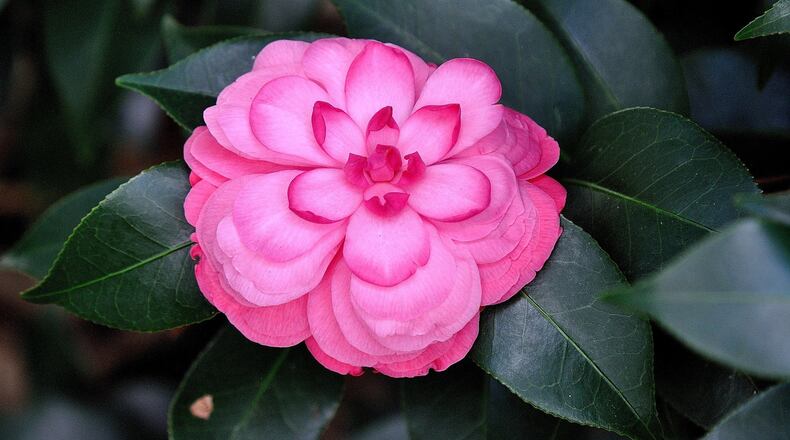At ‘The Garden Guy’s’ house a couple of Camellia sasanquas have started showing a little color while at the Coastal Georgia Botanical Gardens in Savannah they are already claiming the first Camellia japonica of the year. This is amazing because the Camellia japonica is normally a late winter and early spring bloomer.
Early Wonder is a most appropriate name as it does shake the foundation of all you think you knew about Camellia japonicas, from when they bloom to how long they bloom. Take it from someone who was the Director of that botanical garden with over 1,000 camellias. Can you imagine a beautiful rose pink formal double camellia starting bloom in late September and continuing through December?
That was the sequence every year at the Coastal Georgia Botanical Gardens in Savannah. Like all digital cameras mine too documents the date of photographs and I have photos of Early Autumn taken the last week of September. Did you notice that this time I am referring to it as Early Autumn?
That is possibly the name you might find at some nurseries. Never have I been more frustrated with the green industry and what travails it took a regular gardener to locate a source. This is a stunning and amazing shrub that the world needs yet it was like searching for a four-leafed clover.
The Southern Living Plant Collection has come in on the proverbial ‘white horse’ rescue and has added this camellia to their dynamic group of plants under their new name Early Wonder. Now hopefully everyone can take this stunning Camellia japonica out of the pit of obscurity.
How many Zone 7 gardeners, have had their Camellia japonica blossoms toasted by freezes in March or April. You may have even thought that C. japonicas weren’t for you. With Early Wonder however you’ll be enjoying those dazzling formal double flowers for weeks on end in the fall.
Early Wonder is recommended for zones 7-10 and is cold hardy to zero. Like all other camellias, they require acid soil and perform best in woodland landscapes with high filtered light. October is one of the best months for planting woody shrubs and trees and by all means camellias like Early Wonder. By planting now, we open the door for root growth to increase dramatically before next spring.
Even though top growth may have ceased, roots will continue to develop in the cooler 40 to 50-degree days. When new leaf growth resumes in the spring, the root system will already be established and able to supply the plant’s requirements. In fact, research indicates that planting now will give your plants almost a full growing season’s advantage over those planted next spring.
One thing I try to stress in my seminars is to put not only camellias but-all shrubs in a bed. Just as we prepare a bed to sleep in at night, we must prepare a bed for the life of our shrubs. It only makes sense that if we are going to make an investment in the landscape, we need to do it right. It is so sad to see a fine camellia, like Early Wonder placed in a location where it will be surrounded by turf.
Early Wonder would also make an excellent container plant that could be moved to allow for cold winter protection. The American Camellia Society has great tips for growing containerized camellias.
Garden centers have fresh stock and most have certified nursery workers available to assist you in a season that is much less stressed and rushed. Ask to see if they have Early Wonder Camellia japonicas or if they will get some for you. Tell them it is part of the Southern Living Plant Collection. They will know how to immediately source the plant, and you’ll soon be the envy of the neighborhood.
———
Norman Winter, horticulturist, garden speaker and author of, “Tough-as-Nails Flowers for the South” and “Captivating Combinations: Color and Style in the Garden.” Follow him on Facebook @NormanWinterTheGardenGuy.
About the Author
Keep Reading
The Latest
Featured


